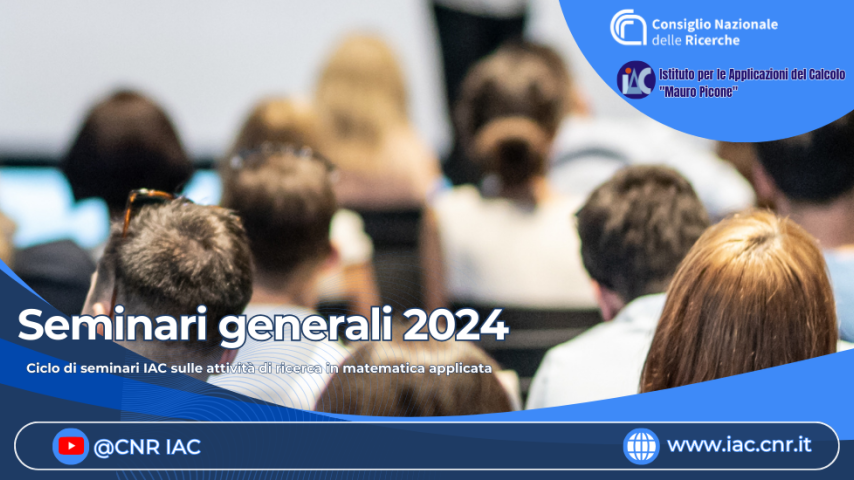
Riparte il ciclo di seminari dell'IAC dedicati alle attività di ricerca in matematica applicata A.A. 2024/2025.
I seminari generali sono l'occasione per ricercatori dell'istituto (e non) di presentare le loro ricerche a un pubblico più vasto di quello del proprio settore di riferimento nella matematica applicata. Il linguaggio scelto, non strettamente tecnico, ha infatti lo scopo di stimolare collaborazioni interdisciplinari.
Tutti i seminari sono trasmessi in streaming sul canale Youtube dell'istituto @CNRIAC.
I seminari si tengono sempre alle ore 14:30
DI SEGUITO IL CALENDARIO DEI SEMINARI IN PROGRAMMA:
8 ottobre - Lucas Coeuret, Università di Padova e CNR-IAC
Luogo: aula al primo piano della sede di Roma, via dei Taurini 19
Titolo: Stability of discrete shock profiles for systems of conservation laws
This talk deals with the stability analysis of discrete shock profiles for systems of conservation laws. These profiles correspond to
approximations of shocks of systems of conservation laws by conservative finite difference schemes. Discontinuous solutions appear naturally in the study of systems of conservation laws, which can model many physical situations, such as gas dynamics. Existence and stability of discrete shock profiles for each stable shock of the approximated system of conservation laws is seen as an improved consistency condition and implies that the finite difference scheme should be able to approach discontinuities fairly precisely.
The aim of the talk will be to review some stability results regarding discrete shock profiles and to present a recent effort to extend them. More precisely, most results known up until recently are focused on the stability of discrete shock profiles associated with shocks of small amplitude. The talk will focus on a nonlinear orbital stability result for discrete shock profiles in quite a general setting, where the smallness assumption on the shock's amplitude is replaced by a spectral stability assumption on the linear operator obtained by linearizing the numerical scheme about the discrete shock profile. This nonlinear orbital stability result relies on a precise description of the Green's function of the linearization about discrete profiles.
Questo seminario è supportato da PRIN 2022 PNRR 'Heterogeneity on the road: modeling, analysis and control' (Hero-Mac), P2022XJ9SX, CUP B53D23027920001, PNRR Italia Domani, finanziato da UE, programma NextGenerationEU.
Link YouTube https://www.youtube.com/watch?v=ZLxIgYVfCQU
-----
22 ottobre - Marta Menci, Università Campus Biomedico Roma
Luogo: aula al primo piano della sede di Roma, via dei Taurini 19
Titolo: Simulating Crowd Dynamics: from low to high-density scenarios
In this talk I will present some recent results concerning modelling and simulations of collective behaviors emerging in pedestrian dynamics.
Starting from the '70s, a great variety of models have been proposed, spanning different scales of descriptions and approaches.
The focus will be on a novel distance-based zeroth-order discrete-in-time model, which offers a powerful tool for simulating crowd behavior at a microscopic level. This model is specifically designed to reproduce key self-organizing patterns typically observed in crowds, as well as the propagation of material waves that emerge in high-densities scenarios. Unlike well-established models of the literature, the proposed model provides a novel perspective by eliminating common issues found in the widely-used social force model, such as unrealistic inertia and oscillatory movements. These refinements make the model more reliable and accurate for practical applications.
I will show how the models considered during the talk can handle a variety of real-world scenarios and challenges through a series of numerical simulations.
Link YouTube: https://www.youtube.com/watch?v=ETefZV5uZqY
-----
19 novembre - Francesca Pelusi, CNR-IAC sede di Napoli
Luogo: CNR-IAC sede di Napoli, Via P. Castellino 111 (Na), sala 1
Titolo: Thermal Convection in Emulsions: Heat Transfer Properties and Role of Droplets
This study explores the dynamics of emulsions—liquid droplets dispersed within another liquid—under buoyancy-driven thermal convection using lattice Boltzmann numerical simulations. We focus on the heat transfer properties of emulsions with varying droplet concentrations, examining cases from dilute to highly concentrated yield-stress emulsions exhibiting a complex non-Newtonian rheology. We investigate how the combination of complex rheology and the presence of finite-sized droplets influences the statistically steady convective state of emulsions under thermal convection. Specifically, at low buoyancy forces, just above the conduction-to-convection transition, we observe that heat transfer fluctuations increase with droplet concentration, due to the presence of finite-sized droplets. However, if the emulsion exhibits a yield-stress non-Newtonian behavior, the transition to convection requires an initial intermittent transient dynamics, during which rapid bursts of heat transfer are spaced out by long-lasting conductive periods, ultimately leading to phase inversion. To complete the above scenario, we then increase the buoyancy force and observe that it can trigger significant structural changes: droplets may undergo breakup, coalescence, and even phase inversion, resulting in a drastic variation in the emulsion rheology. Our findings link macroscopic heat transfer properties to droplet-scale dynamics, providing new insights into complex fluid behavior with broad applications in materials science, pharmaceuticals, and beyond.
Link YouTube: https://www.youtube.com/watch?v=3jAHCVJDcQU
-----
3 dicembre - Francesco Solombrino, Università di Napoli Federico II
Luogo: CNR-IAC sede di Napoli, Via P. Castellino 111 (Na), sala 1
Titolo: A fractional approach to strain-gradient plasticity: beyond core-radius of discrete dislocations
In this talk we derive a strain-gradient theory for plasticity as the Γ-limit of discrete dislocation fractional energies, without the introduction of a core-radius. By using the finite horizon fractional gradient introduced by Bellido, Cueto, and Mora-Corral of 2023, we consider a nonlocal model of semi-discrete dislocations, in which the stored elastic energy is computed via the fractional gradient of order 1 − α. As α goes to 0, we show that suitably rescaled energies Γ-converge to the macroscopic strain-gradient model of Garroni, Leoni, and Ponsiglione of 2010.
This is a joint work with Stefano Almi (Università degli Studi di Napoli “Federico II”), Maicol Caponi (Università degli studi dell’Aquila), and Manuel Friedrich (FAU Erlangen-Nurnberg).
Link YouTube: https://www.youtube.com/watch?v=0upn2eImPiM
-----
****************************************************
Calendario degli anni precedenti
A.A. 2023/2024
19 marzo - Matteo Paoluzzi, Ricercatore IAC-CNR (sede di Napoli)
Luogo: aula al primo piano della sede di Roma, via dei Taurini 19
Titolo: Collective Behavior in Living Materials
Active Materials are collections of self-propelled particles that serve as model systems for several biological systems ranging from epithelial tissues to bacterial microfilms. Because of their non-equilibrium dynamics, active systems can show condensed phases that are prevented by fluctuations at equilibrium. For instance, active particles can condense even in the absence of any attractive force, develop collective long-ranged polar order in two spatial dimensions, and produce spontaneous currents once embedded into complex environments. In this talk, I will show how most of the peculiarities of scalar active systems can be rationalized in terms of persistent random walks. I will explore the impact of such non-equilibrium dynamics on a coarse-graining scale where it is possible to observe a phase separation driven by the noise.
Link streaming QUI: https://www.iac.cnr.it/matteo-paoluzzi-i-seminari-generali-delliac-2024
*****
16 aprile - Fabio Difonzo, Ricercatore IAC-CNR (sede di Bari)
Il seminario si svolge martedì 16 aprile, presso la sede CNR-IAC di Bari, in modalità mista, presenza e streaming (vedi link in calce).
Il titolo del seminario è: Physics informed Neural Networks for inverse problems in peridynamics and porous media.
Di seguito l'abstract.
Deep learning is a powerful tool for solving data driven differential problems and has come out to have successful applications in solving direct and inverse problems described by PDEs. When the physics, modeled by a PDE, is fed into a neural network architecture, it gives rise to the so-called Physics Informed Neural Networks (PINNs). In this talk, I will apply PINNs to inverse problems in peridynamic theory, mobile-immobile and generalized multi-rate transfer models and optimal control problems in the framework of Richards’ equation. In particular, I will show results about PINNs, applied to inverse problems in standard diffusion equations, based on Radial Basis Function activated layers; adaptive PINNs for multi-scale models in fluid dynamics; and PINNs used to predict control on moisture content in 2D problems described by Richards’ equation in unsaturated soils.
Link streaming QUI : https://www.youtube.com/watch?v=TCZtQCsRZy0
*****
23 aprile - Martino Fortuna, Assegnista IAC-CNR (sede di Roma)
Il seminario si svolge martedì 23 aprile, presso la sede CNR-IAC di Roma, aula I piano, in modalità mista, presenza e streaming (vedi link in calce).
Il titolo del seminario è: Asymptotic analysis of some semi-discrete models for crystal plasticity.
Di seguito l'abstract.
In this talk we discuss some semi-discrete models for plastic deformations in metals involving the presence of a large number of dislocations. Dislocations are a particular type of defect to the ordered atomic structure of crystalline materials like metals, and their presence and motion in the bulk plays a fundamental role in plastic deformations of the material. Semi-discrete models have been introduced in this context as an analytical tool to study dislocations' effect in metal plasticity. These models are characterized by a hybrid nature: while framed in a continuum setting they retain some of the discrete features typical of dislocations. In particular these models are characterized by energies that depend on a small parameter, proportional to the characteristic length of the crystal lattice. In certain energetic regimes the asymptotic analysis of such energies allows to derive effective energies for plastic deformation. In particular we will focus on the so-called logarithmic regime at which the asymptotic analysis yields in the limit a line tension energy for dislocations. We will then study a rescaled version of such energy and derive, in the sense of Gamma-convergence, a macroscopic plastic energy accounting for possibly diffused dislocations' density.
Link streaming QUI : https://www.youtube.com/watch?v=_1hn9FHYR38
*****
7 maggio - Angela Monti, Ricercatrice IAC-CNR (sede di Bari)
Il seminario si svolge martedì 7 maggio, in modalità mista, presenza e streaming (vedi link in calce).
Il titolo del seminario è: Population outbreaks in host-parasitoid models:the role of on-off intermittency.
Di seguito l'abstract.
In the recent literature the emergence of “on-off”intermittency has been observed in the Beddington-Free-Lawton host-parasitoid model, when system bifurcation parameters have stochastic (random) temporal variations [1]. Here we show the onset of “on-off ”intermittency in a neighborhood of the free-parasitoid fixed point, for a random variation of the growth rate coefficient r [2]. In addition, we show what are the effects in terms of dynamics and emerging phenomenology when the environmental variability is modelled as a deterministic chaotic driving process [3].
[1] G. Vissio, A. Provenzale, On-off intermittency and irruptions in host-parasitoid dynamics, Journal of Theoretical Biology, 2022.
[2] A. Monti, F. Diele, C. Marangi, A. Provenzale, The onset of intermittency in the Beddington-Free-Lawton model, Communications in Nonlinear Science and Numerical Simulation, 2024.
[3] F. Diele, D. Lacitignola, A. Monti, On-off intermittency in a host-parasitoid model with a deterministic chaotic driver, International Journal of Bifurcation and Chaos, 2024.
*****
21 maggio - Mario Pezzella, Ricercatore IAC-CNR (sede di Napoli)
Il seminario si svolge martedì 21 maggio, in modalità mista, presenza e streaming (vedi link in calce) presso l’area territoriale di ricerca Napoli1 (Via P. Castellino 111), sala 1.
Il titolo del seminario è: Integro-differential Modeling of Infectious Disease Outbreaks: Numerical Insights.
Di seguito l'abstract.
The age-of-infection integro-differential model, originally proposed by Kermack and Mc-Kendrick, provides a versatile yet computationally challenging framework for comprehensively describing various scenarios of infectious disease outbreaks. In this presentation, we address the challenges associated with the long-time simulation of this epidemic model and its extension to heterogenously mixed host populations by introducing dynamically consistent numerical methods. Specifically, we present unconditionally positive and high-order schemes based on Non-Standard Finite Difference and Direct Quadrature methods. Moreover, we conduct an investigation into the asymptotic behavior of solutions to non-linear implicit Volterra discrete equations. By applying these outcomes to numerical methods for age-of-infection models, we rigorously demonstrate the convergence of the discrete final size of the epidemic, establishing our schemes as reliable tools for assessing the long-term behavior of outbreaks.
*****
3 giugno - Prof. Uri M. Ascher, University of British Columbia
Il seminario si svolge lunedì 3 giugno, in modalità mista, presenza e streaming (vedi link in calce) presso l'Università degli Studi di Bari
Il titolo del seminario è: Wrong Numerical Solutions for Dynamical Differential Systems
Di seguito l'abstract.
We discuss situations where subtle reasons lead to wrong numerical solutions for differential equations. Such unhappy events often occur in the context of fractional step methods, especially when using conservative time discretizations, and there are some well-known examples for that. But other, rather different situations may give rise to similar phenomena as well. These will be demonstrated by computational examples, including the simulation of friction, damping and contact effects in deformable object motion arising in computer graphics animation and robotics.
*****
18 giugno - Lorenzo Balzotti, Dipartimento di Ingegneria Informatica Automatica e Gestionale "Antonio Ruberti, Sapienza
Il seminario si svolge martedì 18 giugno, presso la sede CNR-IAC di Roma, aula I piano, in modalità mista, presenza e streaming
Il titolo del seminario è: Knowledge Graphs: embeddings, link prediction and explanation.
Di seguito l'abstract.
Knowledge Graphs (KGs) are data structures that integrate information into a network of entities and relations. They are essential for organizing and retrieving knowledge in various domains, from search engines to recommendation systems. In this seminar, we will introduce the fundamentals of KGs and examine some of the key challenges they present. In the first part, we will discuss methods to address their incompleteness, exploring methodologies for predicting missing links. In the second part, the seminar will delve into the emerging field of AI explanation, emphasizing its importance in enhancing the transparency and trustworthiness of KG embedding systems.
*****







